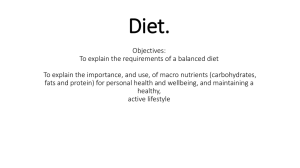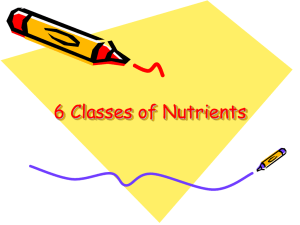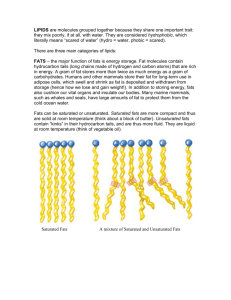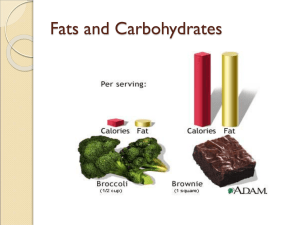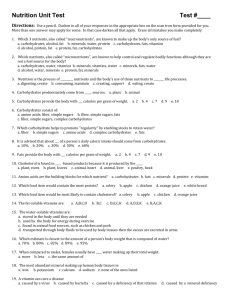Organic molecules - Florida State College at Jacksonville
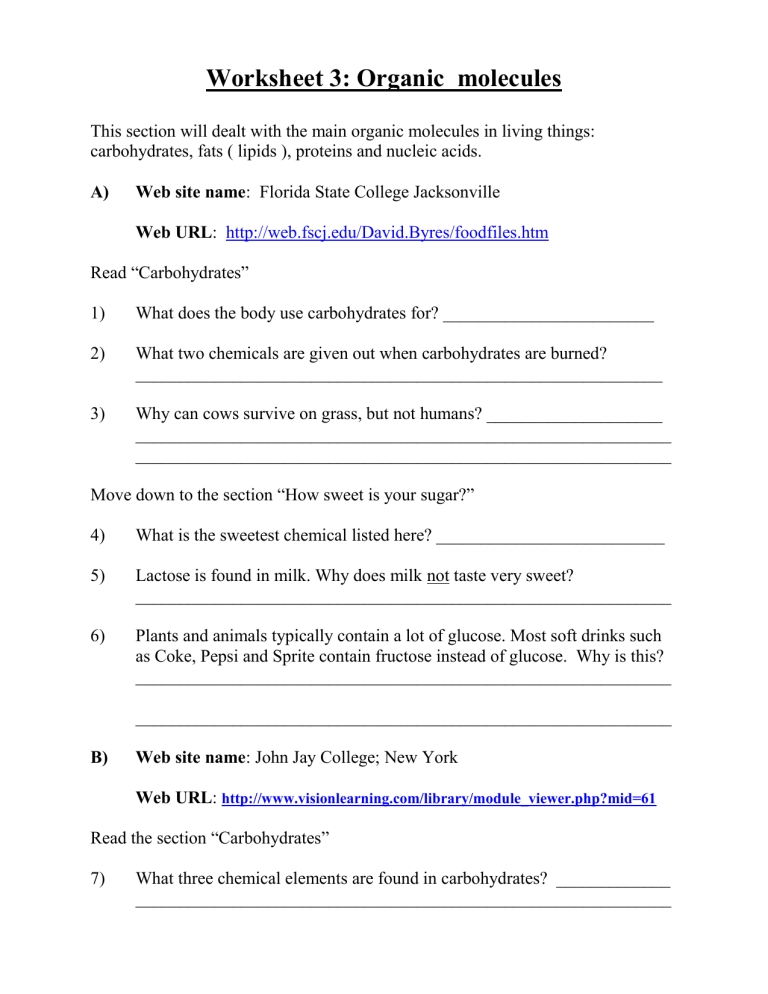
Worksheet 3: Organic molecules
This section will dealt with the main organic molecules in living things: carbohydrates, fats ( lipids ), proteins and nucleic acids.
A) Web site name : Florida State College Jacksonville
Web URL : http://web.fscj.edu/David.Byres/foodfiles.htm
Read “Carbohydrates”
1) What does the body use carbohydrates for? ________________________
2) What two chemicals are given out when carbohydrates are burned?
____________________________________________________________
3) Why can cows survive on grass, but not humans? ____________________
_____________________________________________________________
_____________________________________________________________
Move down to the section “How sweet is your sugar?”
4) What is the sweetest chemical listed here? __________________________
5) Lactose is found in milk. Why does milk not taste very sweet?
_____________________________________________________________
6) Plants and animals typically contain a lot of glucose. Most soft drinks such as Coke, Pepsi and Sprite contain fructose instead of glucose. Why is this?
_____________________________________________________________
_____________________________________________________________
B) Web site name : John Jay College; New York
Web URL : http://www.visionlearning.com/library/module_viewer.php?mid=61
Read the section “Carbohydrates”
7) What three chemical elements are found in carbohydrates? _____________
_____________________________________________________________
8) Look at the chemical formula of glucose. How many Carbon (C) atoms does it have? ________________________________________________
9) What two molecules (or units) are joined to form sucrose?
_____________________________________________________________
10) What is the difference between starch and glycogen? __________________
_____________________________________________________________
11) List four common sources of starch : _______________________________
_____________________________________________________________
C) Web site name: Health Check Systems
Web site address: http://www.healthchecksystems.com/label.htm
12) How many calories are there in 1 gram of carbohydrate?___________
1 gram of fat? ___________
13) Why are “Krispy Krunchies” not a very healthy choice of food? _________
_____________________________________________________________
_____________________________________________________________
Look at the “FDA Specifications for Healthy claims”
14) Does “Fat-Free” really mean “no fat”? _____________________________
Give a practical reason why it would be hard to label any food as “Fat-Free” if it had to have zero fat in it? ____________________________________
_____________________________________________________________
_____________________________________________________________
15) What % of the Daily Values for Vitamin A, Vitamin C etc does food labeled
“Healthy” have to have? ____________ %
16) Do you think any of these health claims on the chart are misleading? _____
If so, which ones? _____________________________________________
_____________________________________________________________
_____________________________________________________________
D) Web site name: Mayo Clinic
Web URL: http://www.mayoclinic.org/healthy-lifestyle/nutrition-andhealthy-eating/in-depth/fat/art-20045550
Read “Nutrition and healthy eating”
17) What does dietary fat provide for the body? _________________________
18) What are four specific diseases that are a concern with some types of dietary fat and cholesterol?
_____________________________________________________________
_____________________________________________________________
19) What are the main sources of harmful saturated fat?
_____________________________________________________________
_____________________________________________________________
20) List the main plant sources of healthier omega-3 fatty acids:
_____________________________________________________________
E) Web site name: New England Journal of Medicine
Web site address: http://content.nejm.org/cgi/content/abstract/337/21/1491
Read “Dietary Fat Intake and the Risk of Coronary Heart Disease in Women”
21) How many women in the study suffered from heart attacks ( myocardial infarction) ? ___________________________________________________
22) Was total fat intake related to the risk of coronary disease? _____________
23) How much does it reduce the risk of heart attack if women replace 5% of energy from saturated fats with energy from unsaturated fats? _______%
(Saturated and trans unsaturated fats are found in animal products (meat, milk) and margarine. Unsaturated fats are common in plants.)
F) Web site name: Science News
Web URL: http://www.sciencedaily.com/releases/2012/05/120517131703.htm
24) How many hours a day did the “limited eating” mice fast? ______________
25) After 100 days, how much less did the time-restricted feeding mice weigh compared to the mice who ate frequently? _______________________
26) What is “brown fat”? __________________________________________
____________________________________________________________
____________________________________________________________
27) Chronic inflammation has been implicated in which diseases?
___________________________________________________________
___________________________________________________________
G) Web site name: Florida State College at Jacksonville
Web URL: http://web.fscj.edu/David.Byres/protein.html
28) What is the name for the two chemical groups (NH
2
and COOH) bonded to the alpha carbon atom?
___________________________ and ____________________________
29)
What is the “secondary structure” of a protein ?
____________________________________________________________
30) What is the molecular weight of insulin? _______________ daltons
31) What is meant by “Proteins can denature ”? _________________________
_____________________________________________________________
H) Web site name: Florida State College at Jacksonville
Web URL: http://web.fscj.edu/David.Byres/proteins.htm
32) When was the word “protein” first used? ___________________
33) What are the best sources of plant protein? __________________________
34) Many pharmacies and stores sell protein or amino acid pills as dietary supplements. What are two problems that can be caused by eating too much protein ? ______________________________________________________
35) If you are on a diet and eating very little food, why should you include some protein in your diet? ____________________________________________
I) Web site name: University of Connecticut
Web URL: http://web.fscj.edu/David.Byres/dnaorganic.html
Read “Evidence that DNA is the genetic material”
36) Why did scientists in 1900 think that proteins were the genes, rather than
DNA? _______________________________________________________
_____________________________________________________________
37) When did Alfred Hershey and Martha Chase finally show that DNA was responsible for bacterial virus infection? ____________________________
38) Who discovered in 1947 that the % of bases in DNA varies from organism to organism?
_____________________________________________________________
39). What four bases (use letters) are found in DNA? _____________________
40). What is a helix? ________________________________________________
41). What does the enzyme helicase do? ________________________________
_____________________________________________________________
42). What does the enzyme ligase do? __________________________________
_____________________________________________________________
43). How many UV-induced errors in the DNA of every skin cell are caused by
4-hours at the beach? _________________________



